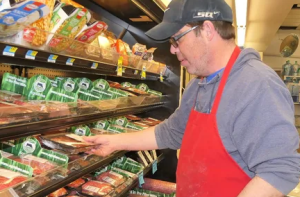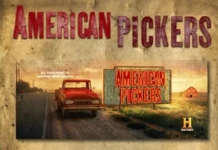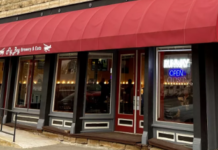Looking to own a cow or steer but not have the responsibility of feeding and housing it?
A Kansas direct-to-consumer agriculture company, Agridime, brings consumers from urban centers across the U.S. together with ranchers. Consumers can participate in ranching by buying ownership in the cattle they will eventually consume or simply purchasing a sirloin steak, brisket or ground beef online or in a market.
If the consumers want, they can drive to the ranch in central or western Kansas, Arizona, Missouri and Oklahoma and meet their own cow or steer, and when it’s time for processing, they can share in the profits. In addition, the company sells boxed and portioned meat that is shipped directly to a home or business. Beef can also be purchased in their warehouses in Herington, Kansas and Gilbert, Arizona.
This turned-around beef-to-table concept is the brainchild of two brothers who grew up on a ranch in central Illinois and spent summers helping their grandfather with his cattle on his ranch in Missouri.
Josh and Jason Link run Agridime, which has contracts with ranchers in central and western Kansas, as well as Arkansas, Missouri, Oklahoma and North Dakota that supply the cattle to this out-of-the-box model that started a few years ago in Kansas.
Consumers can invest in a herd or a single animal, depending on their interest or financial ability. By having consumers buy the animals directly or buy the cuts of beef or beef boxes, Agridime is allowing ranchers to do what they do best: raise cattle, both grass-fed and conventional. The rancher does not have to worry about selling to feedlots or negotiating with consumers or grocery stores.
The Links saw the cattle industry was changing, and because of their ranching background, they wanted the rancher to have more say in what happened with their end product. They decided to use Kansas as a base for their business because of the state’s ideal prairie.
Josh Link met up with Kevin Morgan at Morgan Creek Farms near Hope, Kansas, in Dickinson County.
Morgan grew up on a ranch. Like his father, and his grandfather before him, he raised cattle conventionally for decades. As a fifth-generation rancher, he wanted to go back to the old ways, having cattle graze on his pasture. He and both Links hooked up, helping to form the backbone of Agridime.
“Josh and Jason and I, we started seeing problems within our industry that were pretty obvious to everybody,” Morgan said. “And as we worked through it, we started to see that we all kind of had the same solutions to those problems, and we turned that into a vision.”
One of the beef packing warehouses is located in Herington, Kansas, just down the road from Morgan’s ranch. In addition to shipping pork, chicken and beef out of this warehouse, the company sells their product at the local grocery story, Barnes Heartland Foods in Herington.
“To see that process go from a few guys with a vision to a retail section full of meat that came from your own work, is a pretty humbling experience,” Morgan said.
It’s a win-win situation for the grocery store as well.
“It’s a locally grown product with better quality beef that is very price comparative,” said Chris Barnes, the manager of Barnes Heartland Foods. “We know where it’s coming from. The product speaks for itself.”
Barnes said he started buying from Agridime during COVID and hasn’t stopped.
“By using the local guys, we never ran out,” he said. “Our customers love the products.”
Buying directly from the rancher
Ranchers across the country are trying to tell their stories and get their product directly into the consumer’s hands. But sometimes this can be difficult, as ranchers must take care of their animals and often don’t have time to worry about how to ship the product or where to slaughter the animal, as often waiting lists are long.
Some of the work of bringing farm and ranch products directly from the the producer to consumers started before COVID, but the movement increased dramatically after the epidemic.
“After they (the producer) developed relationships with consumers, and some trust with some educational work, this provided the opportunity to then do some direct marketing,” said Matt Teagarden, CEO of the Kansas Livestock Association. “And then COVID provided additional opportunities.”
Teagarden said this direct to consumer model continues to grow “based on the number of of ranchers and producers who have some kind of online presence and are doing some direct to consumer marketing.”
The Kansas Beef Council has a page on their website that tells consumers where they can purchase Kansas beef directly from the rancher.
“What we’ve done there is made that available to producers across the state,” Teagarden said.
The site gives a little bit of detail about the rancher, how they’re selling the product and if they have a retail store,
“The difference (between buying directly from the producer or the rancher) is that direct from the rancher you know that consumers are going to have some kind of relationship with that ranch or that producer, even if it’s just that one transaction, there’s a deeper relationship,” Teagarden said. “They’ve learned about the operation; they get to know the family. I think sometimes the consumer family visits the ranch family. It goes much beyond just a purchase of meat.”
Kansas is sixth in the nation for head of beef cows, with 1.3 million head and third nationally for cattle on ranches and feed yards, totaling about 6.25 million. In 2021, Teagarden said, the cattle industry made up $9.85 billion in cash receipts in Kansas.
Agridime’s executive director and co-owner, Josh Link said he wants both consumers and producers to make agricultural decisions based on spending every dime wisely. From rancher to butcher to buyer, Agridime is in control of the supply chain, running more than 15,000 head of cattle in central Kansas.
The cattle raised and sold on Agridime’s partner ranches head to a medium-sized processing plant in Texas. This includes the grass-fed cattle, who are both grass-fed and grass-finished, meaning they are not headed to feed yards and fattened up with grains.
By putting together a variety of ranchers and giving them access to a larger market and strong supply chain, Link is hoping to change the system and make it more profitable and easier for the rancher. As more people buy cattle from Agridime’s ranchers, those ranchers can hire more workers.
If someone wants to invest in an animal, on average, the investors get a 10% to 15% return on investment. Link said, this can amount to about $200 or higher for each angus steer.
“I like to tell people cattle is something that you can see and touch and feel,” Link said. “We just hope that we can continue to be able to feed more cattle and and be able to enter more markets.”
What’s next for Agridime?
Along with selling their product in small grocery stores and online, Agridime has entered the restaurant market by selling directly to eateries and soon hopes to open their own farm-to-table dining experience in Kansas.
In addition, the company has branched out into spices and ready-made-meals, using meat products. They also own their own chicken and hog farms and offer these products online.
“The chickens are free range, no antibiotic, no hormone and also no GMO grains are fed to the chickens,” Link said. “The pigs, they are outside. They’re not confined. They were what I’d call (raised in) an open-air environment with no antibiotics, no hormones.”
In addition to chickens and pigs, Link hopes to branch out to sheep and goats, but meanwhile they continue to grow their consumer and product base.
“We’ve more than doubled in size in the last year. I think it just really is a testament to the American consumer’s desire for regenerative agriculture and clean food, nutritious food and knowing where your food comes from,” Link said. “We’re able to do what we do because it’s our producers and our partners that truly make what we do possible.”




